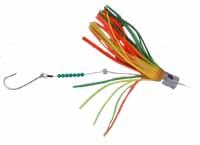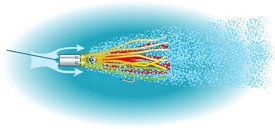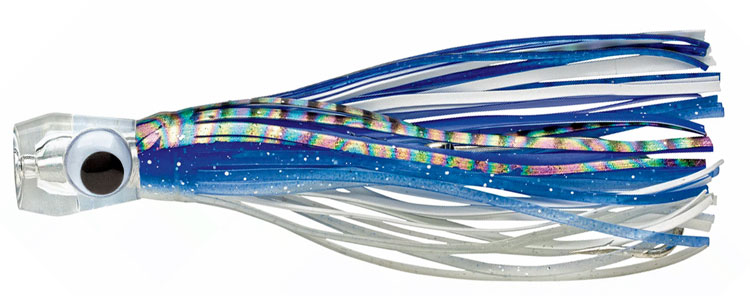- Home
- Artificial Lures
- Lure Heads
Skirted Trolling Lures? It's All In the Shape of the Lure Heads!
The lure heads on skirted trolling lures aren't there just to tie the skirt to. Their size and shape is a vital consideration when deciding which one to buy, and here's why...
No matter how convincing your trolling lures are, they won't catch anything unless the fish know they're there. They need to make their presence known.
Skirted trolling lures achieve this by setting up a long stream of tiny bubbles - the smoke trail.
Produced mainly by the size and shape of the head - although some lure skirts also contribute to it, but to a lesser degree - a good smoke trail is the single most important attribute a skirted lure can have.
Skirted trolling lures have three individual component parts, the hook, the skirt and the lure head.
 Components of s skirted lure - head, skirt, beads (for correct positioning of the hook) and the hook.
Components of s skirted lure - head, skirt, beads (for correct positioning of the hook) and the hook.The larger the frontal area of the lure head, and the least hydrodynamically efficient its shape, then the greater the disturbance it will create in the water as it's drawn behind your boat.
It's at this point the skill of the lure designer comes in. He needs to be able to translate the disturbance made by the lure into a long stream of tiny bubbles, not spasmodic releases of large ones, and all while enabling the lure to track straight and true.
A lure that zooms around erratically may well attract fish, but they probably won't be able to catch it. An enviable feature in a teaser, but not so in a lure.
 A good lure skirt will produce a trail of fish-attracting bubbles - the smoke trail.
A good lure skirt will produce a trail of fish-attracting bubbles - the smoke trail.Predatory fish respond aggressively to flashes and glints of light
reflecting from the silvery sides of baitfish, so it's reasonable to
expect a similar reaction to trolling lures that do the same.
Lure manufacturers capture these features in creating skirt heads with holographic eyes, and internal and external reflective surfaces. It all helps.
Not only do the size, shape and detailing of the lure head surface affect the intensity and length of the smoke trail, it also has a great influence on how the lure behaves in the water.
Skirt head designs can be categorised under three main types. We'll take a look at each of them in turn:~
Lure Heads - Shapes and When to Use Them
Bulletheads
These missile shaped lure heads are made of steel or chromed brass. Relatively heavy, they're less likely to break the surface than lures with resin heads.
 Bullethead
BulletheadTheir efficient hydrodynamic shape offers relatively little resistance, so the smoke trail is not so pronounced as with a blunt faced lure head.
Jetheads are bulletheads with longitudinal holes drilled through them - a feature which helps to improve the smoke trail.
Both types tend to get blown around in windy conditions, as their hydrodynamic shape doesn't give them much grip on the water. They lose effectiveness as a result.
They're best suited for deeper trolling, and are often used with downriggers where they're very attractive to wahoo in particular.
Flatheads
Often made of alloy or resin, these head shapes have their face cut at 90 degrees. As they offer more resistance to the water than bulletheads, they have better 'grip' and are a better choice in marginal conditions.
 Flathead
FlatheadFlatheads track straight, occasionally breaking the surface, splashing and popping much like a flying-fish on their return from flight.
A derivation of a flathead is a 'chugger'. In these, the flat face has been hollowed out, giving them an even better grip on the water and a head-shaking action.
An obvious choice when the sea's getting up and you're starting to wonder if you ought to be fishing at all.
Chuggers are well-suited to having holes through them, and these versions generate really impressive bubble trails.
Slantheads (or 'diggers')
These skirt heads have their faces cut at an angle. The more sloping the face, the more aggressive the action. There are two derivatives - pusherbaits and taperbaits - and, again, can be made of alloy or resin.
 Slanthead
SlantheadPusherbaits are at their best in gentler sea states. Also known as straight runners, these track on or just below the surface creating a deal of disturbance, as they dart from side to side.
Taperbaits similarly have the slanted face are moulded with an increasing diameter from front to back. These tend to run sub-surface most of the time, but occasionally break out much like a flathead.
Just to complicate matters further, those with longer tapered heads are often known as plungers. These have a more aggressive action and can be used effectively over a wide range of conditions.
Artwork by Andrew Simpson
Recent Articles
-
Sea Fishing Rods and Reels Must Be Compatible for a Balanced Outfit
Mar 08, 21 08:30 AM
A quality reel fitted to a quality rod doesn't necessarily make it a quality outfit. Your fishing rods and reels have to be properly matched if you're to get the best out of them, and here’s how -
Essential Lure Fishing Tips That All Saltwater Anglers Should Know
Mar 08, 21 04:51 AM
Which single lure fishing tip applies to trolling, jigging, baitcasting, spinning, fly fishing and any other branch of lure fishing? Well, it is the one at the top of this list -
Vital Jig Fishing Tips That You Really Cannot Afford To Miss!
Mar 07, 21 10:20 AM
Essential jig fishing tips to help you select the right lure for successful jig fishing, together with the techniques required to get the most out of your jig fishing outfit



























New! Comments
Have your say about what you've just read! Leave me a comment in the box below.